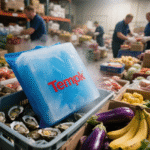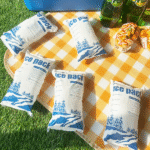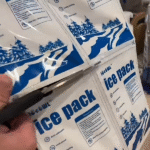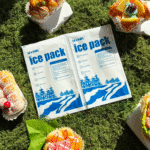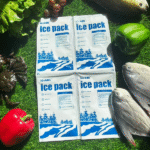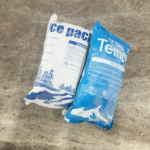What temperature are dry ice packs under real shipping conditions? À pression standard, la neige carbonique se situe à −78,5 °C (−109,3 °F). Chez un expéditeur, internal air typically holds between about −70 °C and −20 °C depending on insulation, ventilation, and pack placement. You’ll see why this range matters, how much dry ice to use, and how to stay compliant in 2025.

-
Exact numbers: what temperature are dry ice packs à la surface, in the box air, and at the product core
-
Sizing made simple: quick math for sublimation rates and a dry ice quantity estimator
-
Safer pack-outs: ventilation, étiquettes (UN1845), and spacing to prevent freeze damage
-
Smart choices: when dry ice beats gel/PCM—and when it doesn’t
-
Tendances 2025: vent membranes, edge-aware loggers, CO₂ recovery, and digital DG workflows
À quelle température sont les packs de glace carbonique dans des conditions d'expédition réelles?
Réponse courte: Dry ice is −78.5 °C at the source; box air stabilizes warmer (≈ −70 °C to −20 °C). Product core lags the air and stays below its spec if you size mass and insulation correctly. This is why what temperature are dry ice packs is a system question, not just a single number.
Pourquoi ça compte: If you must hold ≤−18/−20 °C (glace, desserts congelés, certains produits biologiques), a −78.5 °C “cold battery” gives large safety headroom. Pour 2–8 °C, dry ice is too cold—use gel or PCM to avoid accidental freezing.
How much dry ice to start with?
A practical daily estimator is:
Glace sèche (kg) = (Heures de transit ÷ 24) × Sublimation rate (lb/24 h)
Plan with typical rates by shipper quality and add a 10–30 % buffer for hand-offs and ambient spikes.
| Type d'expéditeur | Qualité de l'isolation | Sublimation typique (lb/24 h) | Ce que cela signifie pour vous |
|---|---|---|---|
| Mousse EPS (≈ 2″ wall) | Excellent | 4–6 | Great for 48–72 h lanes |
| Rigid plastic + doublure | Bien | 6–8 | Balanced cost/hold |
| Ondulé + doublure | Modéré | 8–10 | Add mass or shorten route |
| Pallet foam crate | Prime | 10–20 / palette | Scale with openings and cube |
Pour la pointe: It’s often cheaper to améliorer l'isolation than to keep adding dry ice. Better walls reduce loss across every touchpoint.
Pack placement patterns that actually work
-
Top-load only: puits de froid; watch bottom warm-up on longer lanes
-
Haut + bas: flatter gradients for mixed-density loads
-
Entourer (côtés + haut): most uniform profile; needs more initial mass
-
Interstitiel (between layers): fast pull-down; add spacers for fragile packs
Real-world snapshot: A dessert brand cut temperature excursions by 38 % after switching from top-only blocks to a surround pellet pattern with the same mass.
What temperature are dry ice packs vs. gel and PCM packs?
Fin de compte: Use dry ice for frozen (≤−20 °C). Use gel/PCM for 2–8 °C or CRT.
| Cooling Element | Set-Point / Behavior | Meilleure utilisation | Attention |
|---|---|---|---|
| Glace sèche (CO₂ UN1845) | −78.5 °C sublimes | Deep-frozen lanes | Ventilation requise |
| Pack de gel (0 °C) | 0 °C melts | Aliments réfrigérés | Short hold |
| PCM −21 °C | Phase at −21 °C | Aliments surgelés | Pre-condition |
| PCM +5 °C | Phase ≈ +5 °C | Vaccins | Évitez de geler |
| PCM +22 °C | Phase ≈ +22 °C | CRT lanes | Needs insulation |
What temperature are dry ice packs at the product interface—and is it safe?
Contact risk: A −78.5 °C surface can freeze sensitive items on contact. Add a spacer (ondulé, foam tray) and distribute packs evenly.
Liste de contrôle de la conformité
-
Proper name “Carbon dioxide, solide (Glace sèche), UN1845”
-
Net weight of dry ice on package
-
Ventilé (Jamais hermétique) récipient
-
Classe 9 étiquette de danger
-
Clear shipper / consignee info
| Sujet | Essential Practice | Ce qu'il faut éviter | Pourquoi ça compte |
|---|---|---|---|
| Ventilation | Use vent gaps | Airtight lids | Empêche l'accumulation de pression |
| Étiquetage | UN1845 + poids + Classe 9 | Missing weights | Acceptation plus rapide |
| Manutention | Gants isolés | Bare-hand contact | Avoids frost injury |
Conseils pratiques
-
Door cycles: minimize openings
-
Logger location: near payload core
-
Lane design: prefer predictable curves, not perfect symmetry
How much dry ice do you need for 24–96 h lanes?
Exemple: 48 h lane, Expéditeur EPS, ≈ 5 kg / 24 h →
(48 / 24) × 5 = 10 kg + 10–20 % buffer → 11–12 lb total.
Validation beats theory—tune to your kit and lanes.
2025 trends in dry ice temperature control
Frais dans 2025: Smarter vent membranes, edge-aware loggers, Recapture de co₂, and digital DG workflows cut cost and emissions.
Points forts
-
Microporous vent lids stabilize internal air
-
Edge-aware loggers catch corner leaks early
-
Lower-carbon dry ice from CO₂ capture
-
Digital declarations reduce errors
Perspicacité du marché: Frozen DTC and biologics growth favors lighter, surround pack-outs with better insulation for cost control.
FAQ
Q1: What temperature are dry ice packs at the start of a trip?
About −78.5 °C at surface/core; internal air warms to −70 °C to −20 °C depending on design.
Q2: Puis-je utiliser de la neige carbonique à une température de 2 à 8 °C?
Non. It’s too cold—use +5 °C PCM ou packs de gel.
Q3: Pellets or slabs?
Pellets distribute evenly; Les dalles durent plus longtemps. Hybrid works best.
Q4: How close can dry ice be to my product?
Évitez le contact direct; use a spacer and rely on box air temp.
Q5: Combien de temps dure la glace sèche?
Typically 18–96 h depending on insulation, masse, et ambiant.
Résumé & recommandations
Points clés: What temperature are dry ice packs = −78.5 °C source; box air warmer.
Use dry ice for frozen lanes, PCM/gel for 2–8 °C. Always vent, étiquette, et se connecter.
Étapes suivantes:
-
Define target temp & temps de couloir.
-
Choose correct coolant.
-
Estimate mass + 10–30 % tampon.
-
Use Top+Bottom or Surround layout.
-
Valider avec les enregistreurs.
CTA: Ready to validate a −20 °C or −70 °C lane? Book a 10-minute pack-out review with Tempk.
À propos du tempk
We design validated frozen, réfrigéré, and CRT pack-outs with proven insulation and accessories that hit −20 °C and −70 °C profiles reliably. Every design is backed by pilot data and SOPs that teams can follow easily.

















